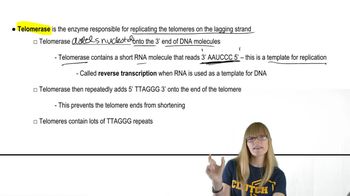Telomeres are found at the ends of eukaryotic chromosomes. What is the functional role of telomeres?
Table of contents
- 1. Introduction to Genetics51m
- 2. Mendel's Laws of Inheritance3h 37m
- 3. Extensions to Mendelian Inheritance2h 41m
- 4. Genetic Mapping and Linkage2h 28m
- 5. Genetics of Bacteria and Viruses1h 21m
- 6. Chromosomal Variation1h 48m
- 7. DNA and Chromosome Structure56m
- 8. DNA Replication1h 10m
- 9. Mitosis and Meiosis1h 34m
- 10. Transcription1h 0m
- 11. Translation58m
- 12. Gene Regulation in Prokaryotes1h 19m
- 13. Gene Regulation in Eukaryotes44m
- 14. Genetic Control of Development44m
- 15. Genomes and Genomics1h 50m
- 16. Transposable Elements47m
- 17. Mutation, Repair, and Recombination1h 6m
- 18. Molecular Genetic Tools19m
- 19. Cancer Genetics29m
- 20. Quantitative Genetics1h 26m
- 21. Population Genetics50m
- 22. Evolutionary Genetics29m
8. DNA Replication
Telomeres and Telomerase
Problem 38a
Textbook Question
Go to the OMIM website (https://www.ncbi.nlm.nih.gov/omim) and type 'dyskeratosis congenita autosomal dominant 1' (DKCA1) into the search bar. The result will include a clickable link to the disorder that has an OMIM number of 127550. Review the OMIM information you retrieve and notice that this disorder is caused by a mutation of a telomerase gene that results in abnormally rapid shortening of telomeres and the appearance of disease symptoms at progressively younger ages in successive generations of the affected families. Use this and other information on OMIM to assist with this problem. Go to reference number 15 at the bottom of the OMIM page for a link to a 2004 paper by Tom Vulliamy and colleagues that appeared in the journal Nature Genetics. Click on the 'Full text' option and download a copy of the paper. Look at Table 1 of the paper on page 448. This table lists the lengths of telomeres measured in members of the families in this study. Telomeres shorten with age, and the telomere lengths in Table 1 are age-adjusted. The negative numbers for telomere lengths in the table indicate that telomeres are shorter than average for age, and the more negative the number, the shorter the telomere. Based on Table 1, the discussion in the Vulliamy et al. (2004) paper, and information available on OMIM, answer the following:
How do telomere lengths in children compare with telomere lengths of their parents?
 Verified step by step guidance
Verified step by step guidance1
Step 1: Access the OMIM website (https://www.ncbi.nlm.nih.gov/omim) and search for 'dyskeratosis congenita autosomal dominant 1' (DKCA1). Locate the disorder with OMIM number 127550 and review the information provided about the genetic basis of the disorder, specifically the mutation in the telomerase gene and its impact on telomere shortening.
Step 2: Scroll to the references section at the bottom of the OMIM page and find reference number 15, which links to the 2004 paper by Tom Vulliamy and colleagues published in Nature Genetics. Click on the 'Full text' option to download the paper.
Step 3: Open the downloaded paper and navigate to Table 1 on page 448. This table lists age-adjusted telomere lengths for members of the families studied. Note that negative values indicate telomeres shorter than average for age, with more negative values representing greater shortening.
Step 4: Compare the telomere lengths of children with those of their parents as listed in Table 1. Observe the trend in telomere shortening across generations, noting whether children tend to have more negative values (shorter telomeres) compared to their parents.
Step 5: Use the observations from Table 1, along with the discussion in the Vulliamy et al. (2004) paper and the information from OMIM, to analyze the generational impact of telomerase gene mutations on telomere length. Consider how this progressive shortening correlates with the appearance of disease symptoms at younger ages in successive generations.
 Verified video answer for a similar problem:
Verified video answer for a similar problem:This video solution was recommended by our tutors as helpful for the problem above
Video duration:
3mPlay a video:
Was this helpful?
Key Concepts
Here are the essential concepts you must grasp in order to answer the question correctly.
Telomeres
Telomeres are repetitive nucleotide sequences located at the ends of chromosomes, protecting them from deterioration or fusion with neighboring chromosomes. They play a crucial role in cellular aging, as they shorten with each cell division. When telomeres become critically short, cells can no longer divide, leading to cellular senescence or apoptosis. Understanding telomere biology is essential for studying age-related diseases and genetic disorders like dyskeratosis congenita.
Recommended video:
Guided course

Telomeres and Telomerase
Genetic Mutations
Genetic mutations are alterations in the DNA sequence that can lead to changes in gene function or expression. In the case of dyskeratosis congenita autosomal dominant 1 (DKCA1), mutations occur in telomerase genes, affecting the enzyme responsible for maintaining telomere length. These mutations can result in accelerated telomere shortening, which is linked to the onset of disease symptoms at younger ages in successive generations. Understanding the nature of these mutations is vital for grasping the disorder's inheritance pattern.
Recommended video:
Guided course

Mutations and Phenotypes
Age-Adjusted Telomere Lengths
Age-adjusted telomere lengths are measurements that account for the expected telomere length based on an individual's age. In studies like the one by Vulliamy et al. (2004), telomere lengths are compared to age-specific norms to determine if they are shorter or longer than average. Negative values indicate that an individual's telomeres are shorter than expected for their age, which can have implications for health and disease risk. This concept is crucial for analyzing the data presented in the study and understanding familial patterns of telomere shortening.
Recommended video:
Guided course

Telomeres and Telomerase

 8:38m
8:38mWatch next
Master Telomeres and Telomerase with a bite sized video explanation from Kylia
Start learningRelated Videos
Related Practice
Textbook Question
572
views
